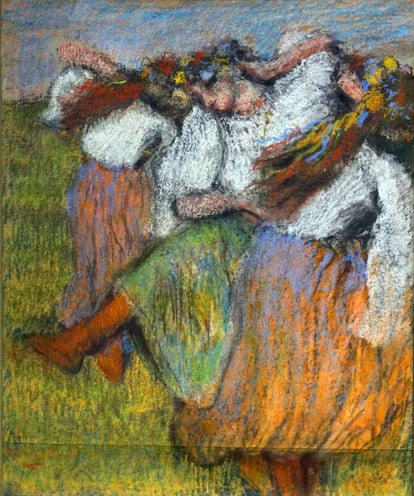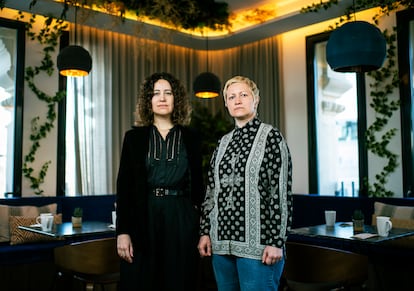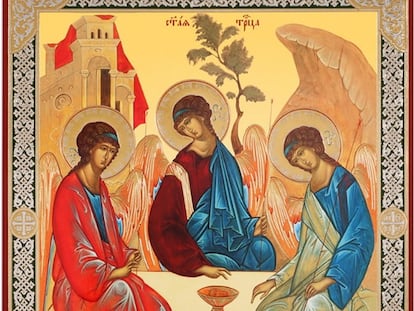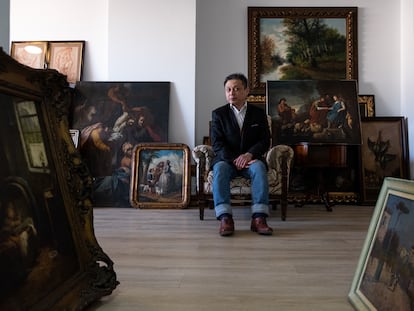Moscow loses a cultural battle as Degas’ ‘Russian dancers’ recognized as Ukrainian
Museums such as the National Gallery and the Metropolitan have agreed to retitle works described in their catalogs as Russian amid an offensive against the Russification of Ukrainian history

Anna Stavichenko says that she doesn’t really like being considered a soldier of Ukrainian culture. “I prefer to call it ‘ambassadors of our country,’ because I am against this idea of putting us on a cultural frontline, when there is a real front and real soldiers.” Stavichenko, 37, was the executive director of the Kyiv Symphony Orchestra. When the war broke out, she fled with her family to Poland. She began to think about how she could contribute to the defense of her homeland. First, she managed to introduce Ukrainian pieces into concerts performed by the Warsaw National Philharmonic Orchestra; later she took the lead in a mission to bring compatriot refugee musicians to orchestras in France. The idea was to fight for the identity of Ukrainian culture against the Russian military steamroller. Art not only as a victim, but as a weapon.
Stavichenko provides a very clear example: “Everyone knows Tchaikovsky, Dostoevsky... because they had great promotion from Russia. Who knows the Ukrainian poet Taras Shevchenko?” The French painter Edgar Degas is also well-known. The series of paintings he produced in Paris around 1899 entitled Russian Dancers has become a focal point for many defenders of Ukrainian cultural identity. Prominent among these is journalist and art historian Oksana Semenik, who exposes and develops daily cases of the Russification of art pieces of Ukrainian origin on social media. Semenik, in a conversation with EL PAÍS from Kyiv, clarifies what she does: “We do not fight for our identity, but to recognize our identity as independent and different from the Russian one.”
Among the first places to join this cultural offensive was the National Gallery in London. In April 2022, this British museum, in light of the situation in Ukraine, decided that it was the “appropriate” time to change the name of Degas’ Russian Dancers to Ukrainian Dancers, with online encyclopedia Wikipedia following suit. Explaining the decision, the gallery said there was no evidence that the painter identified the dancers as Russian — a distinction attributed to the dealer Paul Durand-Ruel, who purchased the work from him. “It has always been pointed out in the academic literature surrounding this work,” the National Gallery said in a note sent to EL PAÍS, “that the dancers were in fact Ukrainian.” National blue and yellow adorn the hair of the women portrayed.
Stavichenko acknowledges that the Russian invasion is a “war of identity.” “It is a war against who we are as a nation,” she says. “That’s why culture is so important, because with culture we can prove that we have existed for centuries.” It was over a century ago that Degas noticed these women in traditional dress performing folk dances from Eastern Europe. He went on to dedicate nearly 20 paintings and drawings to them. After the National Gallery, the Metropolitan Museum of New York moved in, changing the title of one of the works in its catalog, but with a nuance: the Met opted for Dancer in Ukrainian Dress.
A work by Degas in the National Museum of Stockholm also bears a different title. The Swedish gallery explains: “When Edgar Degas created the paintings, Ukraine was part of the Russian Empire, and it is almost impossible to identify with certainty from which part of the empire the dancers of the dance company that traveled to Paris came from.” They looked at the dresses specific to Ukrainian folklore, rather than the identity of the women, leading the museum to catalog the piece in its possession as Three Dancers in Ukrainian Dress.
But this cultural front is broad and not every institution feels the need to change anything for the moment. The Museum of Fine Arts, Houston, has one of the paintings of the dancers in its possession but has retained its original title. Its director, Gary Tinterow, an expert on Degas, notes in an email that the painter was “motivated by artistic exploration and with no intention of being ethnographically or culturally accurate.” He admits that the costumes look Ukrainian, but says that in principle the museum tries to respect the titles given to works by artists or their relatives.

“Decolonization is not new in the museum world,” says Semenik, who was recently in Madrid at the invitation of the Friedrich Ebert Foundation, which held a seminar entitled “War against culture — culture at war.” “Scholars have talked about British colonialism, the French empire and artifacts stolen from indigenous peoples, but it’s only now that people are starting to talk about Russian imperialism.” The historian cites one example of success in the effort to recognize cultural identity: an exhibition recently held at the Thyssen-Bornemisza in the Spanish capital on Ukrainian modernism. It is enough to consider two artists to see the contrasts. The Thyssen presented Kazimir Malevich and Alexandra Ekster as representatives of the Ukrainian avant-garde. At the Museum of Fine Arts, Houston, the two are simply listed as “Russian.”
Semenik recalls the time when he was studying Spanish: “I could hardly find books by Ukrainian authors in Spanish, only Andrii Kurkov. But you can find translations of Dostoevsky or Tolstoy in bookstores, and you will see Anton Chekhov’s plays in theaters. It is not because Russian literature is better than Ukrainian literature. It is because Russia can afford [to promote] it with oil and gas resources.”
Joining Stavichenko in Madrid was documentary film director Zoya Laktionova, a native of Mariupol. She agrees that the identity of her country is the target of the war launched by Russia. “This is why I say that I am Ukrainian, that I have culture,” she says. “In Mariupol, for example the famous painter Arkhip Kuindzhi was born. He is Ukrainian, but Russia always says he is Russian, and I always fight against that.”
According to Laktionova, the New York Met has agreed to modify Kuindzhi’s description to “Ukrainian, born in the Russian Empire.” The museum even went a little further and included a note for the magnificent painting it possesses by the landscape artist, Red Sunset on the Dnieper: “In March 2022, the Kuindzhi Art Museum in Mariupol, Ukraine, was destroyed in a Russian air raid.”
The Kuindzhi Art Museum is one of 256 cultural properties damaged by the Russian offensive that Unesco has managed to document since February 2022. As with Kuindzhi, other major art galleries are following suit with artists such as Ivan Aivazovsky and Ilya Repin, hitherto defined as Russian and now recognized for their Ukrainian origins. “It is important for Ukrainian culture to be in European cultural programs, in concert halls, in museums,” says Stavichenko. “This way, the next time Russia wants to attack, it will be more complicated because the world will know who we are and the reaction will be immediate.”
Sign up for our weekly newsletter to get more English-language news coverage from EL PAÍS USA Edition
Tu suscripción se está usando en otro dispositivo
¿Quieres añadir otro usuario a tu suscripción?
Si continúas leyendo en este dispositivo, no se podrá leer en el otro.
FlechaTu suscripción se está usando en otro dispositivo y solo puedes acceder a EL PAÍS desde un dispositivo a la vez.
Si quieres compartir tu cuenta, cambia tu suscripción a la modalidad Premium, así podrás añadir otro usuario. Cada uno accederá con su propia cuenta de email, lo que os permitirá personalizar vuestra experiencia en EL PAÍS.
¿Tienes una suscripción de empresa? Accede aquí para contratar más cuentas.
En el caso de no saber quién está usando tu cuenta, te recomendamos cambiar tu contraseña aquí.
Si decides continuar compartiendo tu cuenta, este mensaje se mostrará en tu dispositivo y en el de la otra persona que está usando tu cuenta de forma indefinida, afectando a tu experiencia de lectura. Puedes consultar aquí los términos y condiciones de la suscripción digital.
More information
Archived In
Últimas noticias
Welcome to the post-religion era: The idea of Christianity as the absolute truth has become obsolete
‘I thought you would like it’: The risky sexual practice popularized by TV shows and TikTok
The digitalization of tourism: ‘They promise experiences and gave us the worst possible one’
Mexican peso defies uncertainty with forecasts of a new period of stability in 2026
Most viewed
- Sinaloa Cartel war is taking its toll on Los Chapitos
- Reinhard Genzel, Nobel laureate in physics: ‘One-minute videos will never give you the truth’
- Oona Chaplin: ‘I told James Cameron that I was living in a treehouse and starting a permaculture project with a friend’
- Why the price of coffee has skyrocketed: from Brazilian plantations to specialty coffee houses
- Silver prices are going crazy: This is what’s fueling the rally











































